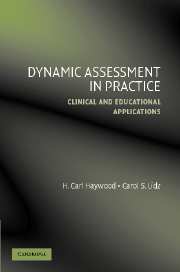Book contents
- Frontmatter
- Contents
- Preface
- Foreword, by Kenneth A. Dodge
- Foreword, by Thomas Oakland
- PART ONE THEORY AND PRINCIPLES
- PART TWO APPLICATIONS
- APPENDIX A TESTS REFERRED TO IN THE TEXT THAT DO NOT BELONG TO THE AUTHORS
- APPENDIX B SOURCES OF DYNAMIC ASSESSMENT MATERIALS
- References
- Author Index
- Subject Index
- Tests and Testing Materials Index
- References
Foreword, by Thomas Oakland
Published online by Cambridge University Press: 04 December 2009
- Frontmatter
- Contents
- Preface
- Foreword, by Kenneth A. Dodge
- Foreword, by Thomas Oakland
- PART ONE THEORY AND PRINCIPLES
- PART TWO APPLICATIONS
- APPENDIX A TESTS REFERRED TO IN THE TEXT THAT DO NOT BELONG TO THE AUTHORS
- APPENDIX B SOURCES OF DYNAMIC ASSESSMENT MATERIALS
- References
- Author Index
- Subject Index
- Tests and Testing Materials Index
- References
Summary
Assessment specialists in the United States and Western Europe are fortunate to be able to select from hundreds of standardized norm-referenced tests. Test authors and test companies continue to provide a steady supply of additional excellent resources. Different assessment models and methods that supplement current resources also are needed, however.
This need was underscored in 1991 as I was preparing to direct the International Test Commission's conference on test use with children and youth at Oxford University. I reviewed then-current literature on desired changes in assessment practice (Oakland, 1995). Assessment specialists were requested to devote more attention to dynamic behaviors (e.g., problem-solving abilities) and less attention to static behaviors (e.g., general intelligence), to assess outcomes needed for the attainment of meaningful life activities, to identify temporary and improvable barriers to performance, and to emphasize formative evaluation methods.
Carol Lidz's book Dynamic Assessment: An Interactional Approach for Evaluating Learning Potential (1987) addressed many of these important issues. Her pioneering scholarship helped set the stage for other scholars and practitioners to become engaged in the use and development of what we now call dynamic assessment. Carl Haywood's early scholarship (e.g., 1992) also helped promote this important and emerging area.
Haywood and Lidz's current collaboration, Dynamic Assessment in Practice: Clinical and Educational Applications, synthesizes foundational scholarship (e.g., from Vygotsky and Feuerstein) and extends it in exemplary ways that enable assessment specialists to address issues I identified in 1991.
- Type
- Chapter
- Information
- Dynamic Assessment in PracticeClinical and Educational Applications, pp. xvii - xxPublisher: Cambridge University PressPrint publication year: 2006



